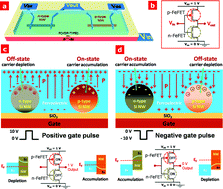Ultralow-power non-volatile memory cells based on P(VDF-TrFE) ferroelectric-gate CMOS silicon nanowire channel field-effect transistors†
Abstract
Nanowire-based ferroelectric-complementary metal–oxide–semiconductor (NW FeCMOS) nonvolatile memory devices were successfully fabricated by utilizing single n- and p-type Si nanowire ferroelectric-gate field effect transistors (NW FeFETs) as individual memory cells. In addition to having the advantages of single channel n- and p-type Si NW FeFET memory, Si NW FeCMOS memory devices exhibit a direct readout voltage and ultralow power consumption. The reading state power consumption of this device is less than 0.1 pW, which is more than 105 times lower than the ON-state power consumption of single-channel ferroelectric memory. This result implies that Si NW FeCMOS memory devices are well suited for use in non-volatile memory chips in modern portable electronic devices, especially where low power consumption is critical for energy conservation and long-term use.


 Please wait while we load your content...
Please wait while we load your content...